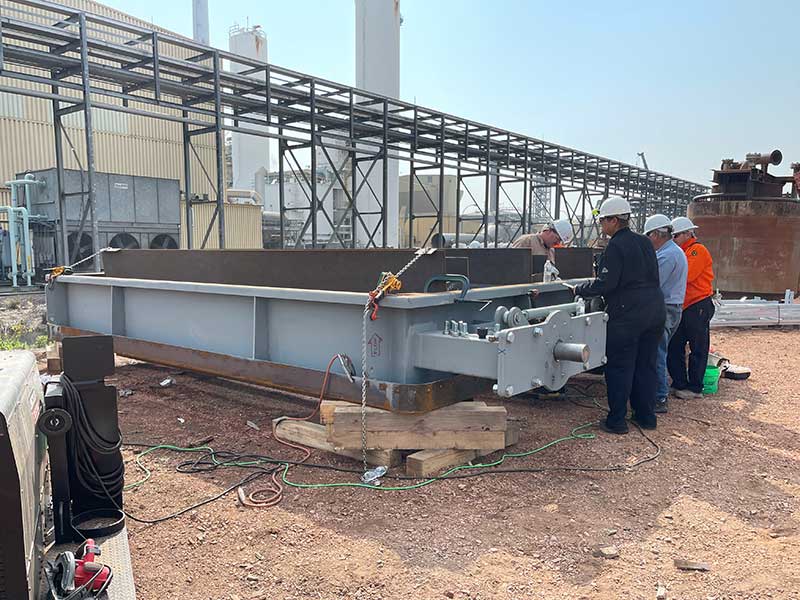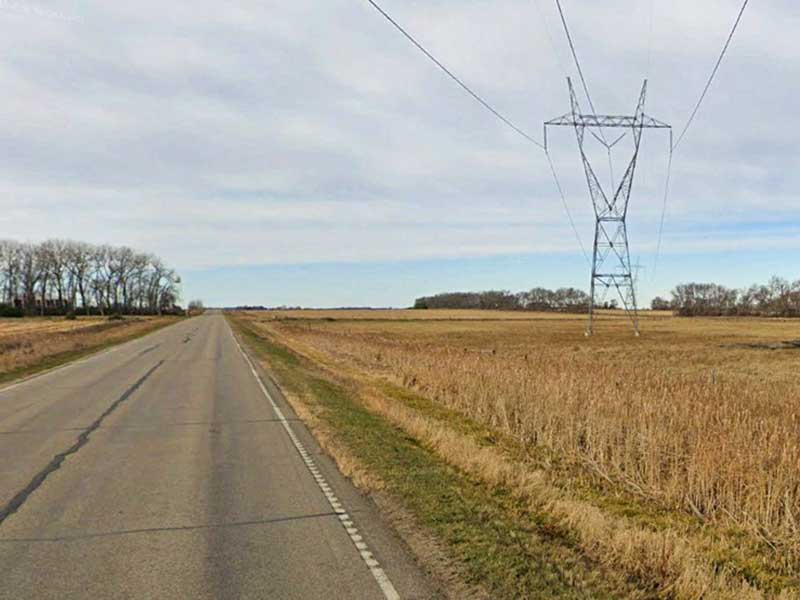The COVID-19 pandemic and subsequent screeching brakes of the economy had widespread impact for several months in 2020, starting in March. There are many industries that were impacted, but let’s look at three in Basin Electric’s service area to learn more about what they experienced.
Dairy undulations
When schools and restaurants closed down in March to help slow the spread of COVID-19, “it’s like a switch flipped. It just happened, and we couldn’t deliver milk to those places anymore,” says Doug Stensland, owner of Stensland Family Farms.
The system that takes milk from production to processing to delivery was disrupted. Grocery stores ran short of milk on their shelves, and prices started to plummet at the same time. It was a blow to dairy farmers who saw milk prices at a high point before COVID-19. In April, milk prices tanked to their lowest level in recent memory and then dropped even further in May. In June, prices rebounded to above their late-2019 heights.
Stensland Family Farms is a 105-year-old operation located near Larchwood, Iowa, a member of Basin Electric Class C member Lyon Rural Electric Cooperative in Rock Rapids, Iowa. Doug Stensland’s daughter and three sons wanted to stick with the business, grow it, and started thinking about what could be different. When the family decided to invest in robotic milking eight years ago, they became totally family-operated.
Then, three-and-a-half years ago, the dairy farm invested in their own processing equipment. A capital-intensive upgrade that may have saved the day.
With processing came vertical integration. The dairy owns and operates three retail stores that carry milk, cheese, butter, cream, and ice cream, and they also sell retail milk to other local groceries. But on top of the milk that ends up in home kitchens, the dairy also sells milk and cheese to daycares and restaurants.
At the time COVID-19 hit, 40% of Stensland Family Farms’ sales were in the wholesale market.
“When daycares and restaurants had to close, that 40% went away overnight,” Stensland says.
Their investment in processing equipment helped them fill some local demand. The cows, unaware of COVID-19’s effects on the world, kept producing milk, and the farm quickly adjusted a segment of that production from daycare and restaurant packaging to the packaging customers buy for their homes.
“The large production facilities had a harder time adjusting quickly because those are immense operations focused on a strict single product production schedule, where we have considerably more flexibility. It takes time to switch production and packaging and on top of that, all those employees needed to start following new [pandemic] safety procedures,” Stensland says.
Large production facilities are focused on efficiencies, but when the system can’t keep up “it can make for a bad deal,” he says. At Stensland Family Farms, the operation’s efficiency means production can turn on a dime.
The dairy was able to fill in gaps that COVID-19 blew open. “In those weeks right after people went home, they were drinking a lot more milk because families were eating at home and kids were drinking milk at home,” he says. “We saw a 25-30% jump. But now that the larger producers have their arms around it, our demand is back to normal.”
Even before the COVID-19 pandemic, Stensland advocated for supporting local businesses. But he is more convinced now.
“There is a uniqueness to this COVID situation that has me looking at things in a different light. Dairy farming is always challenging, but what our family has done for a few years now is helping us get through this,” Stensland says. “It’s better for farms and customers if farms don’t put all their eggs in one basket, so to say. We were a local operation that was able to get milk to customers quickly because we were able to really start pumping out for one particular need. Also, we are close to where the customers are.”
Stensland says 2020 started off with high hopes, and with prices coming back, he feels better than he did just a couple months ago. “I feel for all dairy families. It’s not fair how hard they work. They are good managers, but many just don’t have the size they need to make it, to try to play into this field,” he says.
Ethanol equations
When COVID-19 shut down businesses and schools in March, many people, essential workers excluded, started putting on fewer road miles.
Total miles driven dropped by more than 50% in the last two weeks of March in the United States, according to data collected by Arity, a mobile data analytics company that provides data to insurers. Areas with lower population density did not drop as far as areas with higher population density, and in some states, mileage dropped more than 60% below what would be expected without a pandemic.
This new behavior had an intense effect on oil prices, and therefore ethanol production.
Brad Schardin, general manager at Southeastern Electric Cooperative, a Basin Electric Class C member in Marion, South Dakota, says a fair amount of the cooperative’s revenue is tied to the oil industry. The cooperative’s three largest loads are the TransCanada pipeline, NuGen Energy ethanol plant, and the POET Biorefining - Chancellor (South Dakota) ethanol plant.
“We saw our kilowatt hours drop by 39% through May, and revenue drop by 30% on these large loads as well,” Schardin says.
The corn harvest has been an interesting one as well. In 2019, in Southeastern Electric’s six-county service area, three of the largest counties had only 30-40% of their corn crops planted due to extremely wet conditions causing an unheard of corn shortage for the ethanol plants late last year and into 2020. Schardin says the ethanol plants in Southeastern Electric’s service area decided to stop production in April and ride out the effects of low oil prices, coupled with low ethanol margins, short corn supplies, and finally the COVID-19 pandemic. “They understand there will not be more corn available to buy until the 2020 fall harvest, have worked out details for railed-in corn from North Dakota, or are hanging on to what they have in storage. It’s been a wait-and-see game for them right now. NuGen Energy in Marion just started operating again on June 27 with some North Dakota railcar corn procurements. We believe the other plant will not be up and running until the new corn harvest starts coming in later this fall,” he says.
In May, 36 electric cooperatives and rural electric associations sent a letter to 20 federal lawmakers asking Congress to provide economic relief for rural America due to the impacts of the COVID-19 pandemic.
The letter noted that a steep drop in liquid fuel demand has had a major impact on biofuel plants. The groups asked for relief that specifically benefits food and ethanol processing plants, along with the farmers and ranchers who serve them.
Schardin says that effort was much appreciated by the ethanol producers. “The fact that the co-op would go to bat for them, to present a letter to our congressional delegations and administration, that was incredible to them,” he says. “We advocated for local ag and the feedstocks that come out of ethanol. Sometimes they see their utility bill and forget how reliable and affordable we are. But for our cooperative family to write that letter and hold several nine-state conference calls on the matter, that boosted our stock with them. We offer more than just the price of electricity.”
Schardin is thankful that outside of the oil pipeline and ethanol loads, the cooperative has been on pace for a record year of new members. “Take 2018 – we hooked up 318 new members or services through the end of May. This year, through May 2020, we have 308 new members/services, which puts us on track for matching that record year. It is interesting to note that many of these new members or services are twin homes or small commercial loads, but there are several large loads like the Dakota Access pipeline pumping station, dairy facilities, and a large egg-laying facility all in the background waiting for everything to shake out right now,” he says.
Oil and natural gas strain
The price of oil and its impact on the world economy cannot be overstated. Products made with petroleum, shipped using petroleum, produced using petroleum, and fueled by petroleum are all affected.
By early March, prices had fallen by 30% since the start of 2020. For a brief period, the price of oil was negative, a result of storage being completely full and nowhere to put production.
In North Dakota, about 6,100 of the state’s 16,000 producing wells are now shut in. North Dakota’s rig count has dropped to 11 rigs as of July 10, which is less than a quarter of the average number in March. Production fell to 858,000 barrels a day in May, which is the lowest level since 2013. According to North Dakota Job Service, one-fifth of the state’s oil and gas employees are out of work. The North Dakota Petroleum Council estimates that oil needs to be $35/barrel (bbl) before shutdown wells come back online, and $40/bbl before drilling activity resumes. (Prices noted are WTI prices; oil produced in the Bakken has a basis point of $8 due to the transportation needed to move the oil to market.)
Worldwide, demand for natural gas dropped off in late April, but became most apparent in May and June when liquid natural gas export terminals in the United States reported continued cargo cancellations. When COVID-19 hit, demand for natural gas dropped, but so did production. And, there is continued uncertainty with some states implementing shutdowns once again.
According to Robert Johnston, executive advisor and managing director of Global Energy and Natural Resources at the Eurasia Group, OPEC continued cuts through the end of July, and smaller producers will likely start producing again. Which means $40/bbl will likely continue even as demand ramps up.
Gas production in the Bakken oil play of western North Dakota is expected to decline. The North Dakota Industrial Commission has reinstated a program that allows oil and gas operators to keep wells in “not completed” or “inactive” status to prevent production during an oil collapse. There are 420 drilled but uncompleted wells in North Dakota. Whiting Petroleum Corp., a major Bakken producer, filed for bankruptcy April 1.
For Creedence Energy Services, a company that serves oil and gas operators that have wells in production, discussions about what it would take to survive the price drop began in April. Kevin Black, president of the five-year-old company, says because their business is focused on delivering chemicals that improve production, reduce failures, and optimize efficiencies, their first focus was on their customers.
“We needed to talk about what we were going to do to weather this storm. So, we looked at whether they had the protection they needed for their equipment, especially in the cases of those companies that were shutting in their wells that were already producing,” Black says. “There are specialty treatments we can provide to help that process, like corrosion inhibitors and chemicals to prevent mineral scaling. Those work when the oil is pumping, and when the well is down.”
Black says at one point, the company had to let go a portion of its staff, most of which they were able to bring back by July. “In our area, this impacts families in a big way. Most of our employees also have spouses that work in the oil and gas industry. It was very grueling, but we kept grinding every day to find a way to keep our company alive.”
Black’s company is a member of Mountrail-Williams Electric Cooperative, a Basin Electric Class C member headquartered in Williston, North Dakota. “We had invested in a new state-of-the-art laboratory near Mountrail-Williams’ headquarters building, and it was about half done when prices dropped,” Black says. “We are happy Mountrail-Williams has helped us get through this period, making sure we have the power we need to get the facility going.”
This company, headquartered in Minot, North Dakota, but with all major services in Williston, was started by a group of cousins in November 2014 when oil prices were at $82/bbl. “By April 2015, prices dropped to $42/bbl,” Black says. “We’ve gone through this before, and we got through it by being innovative.”
He says they have found new ways to grow throughout this downturn, too. “We are not trying to get outside of our lane, but we have expanded our footprint, and are way more efficient with new processes and technologies,” he says.




